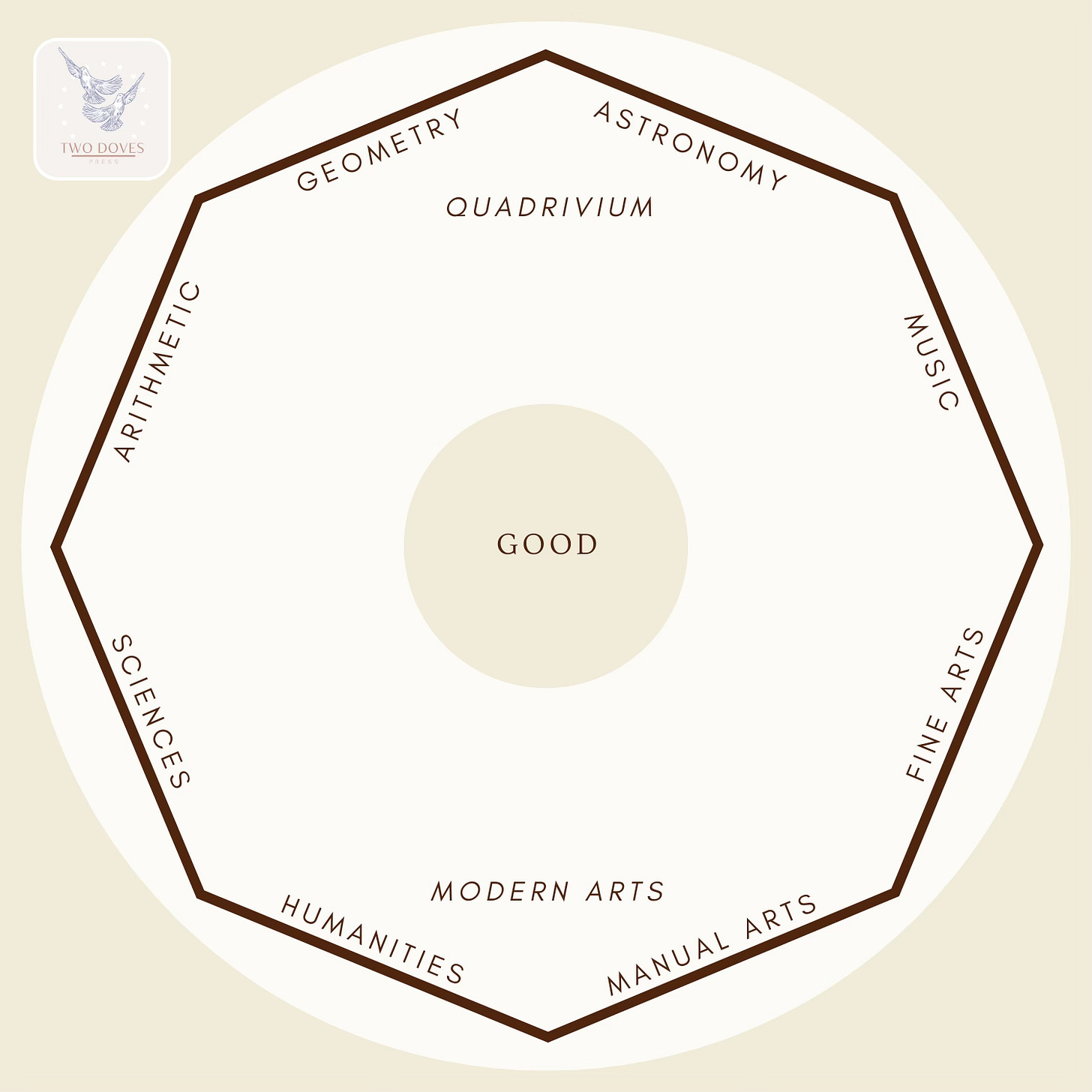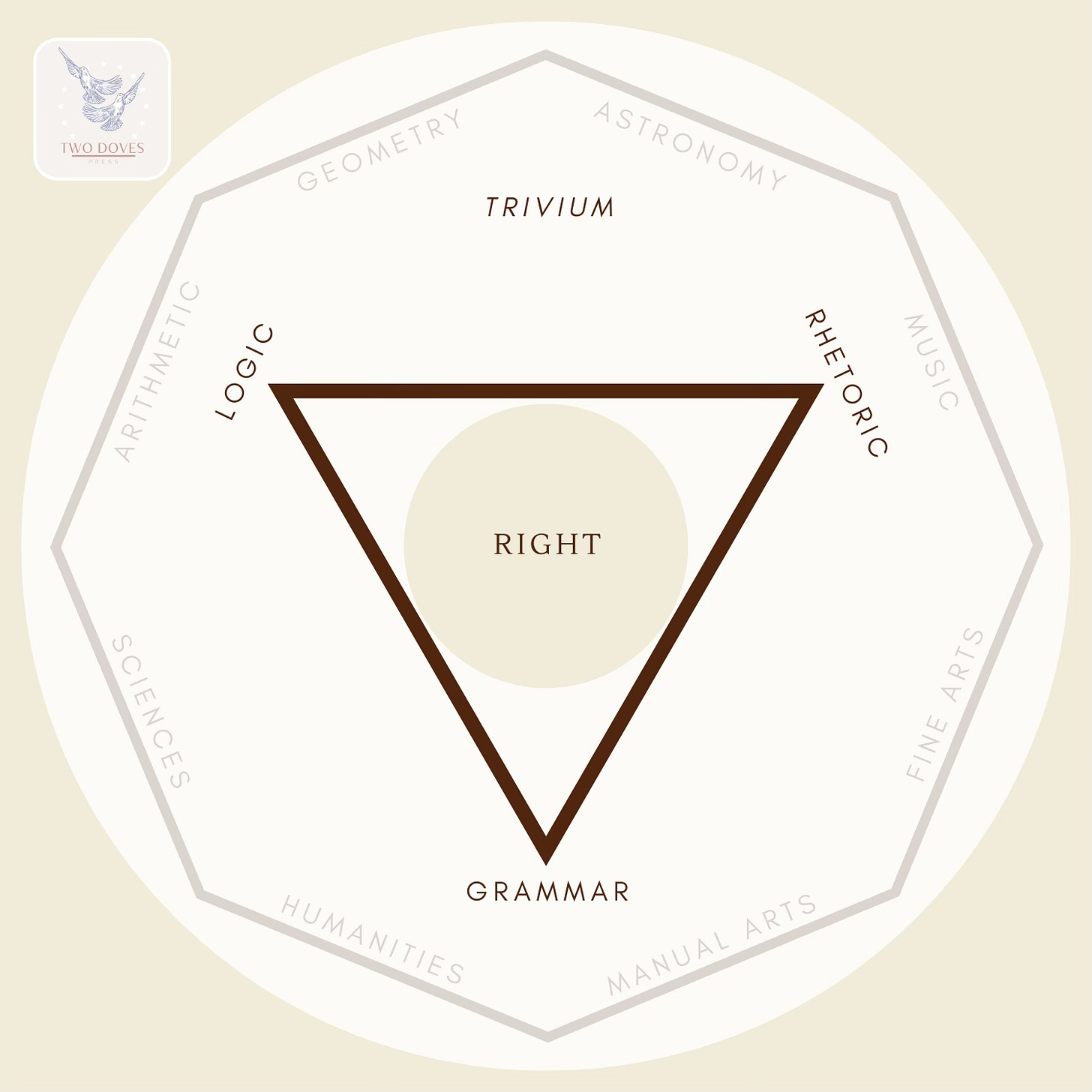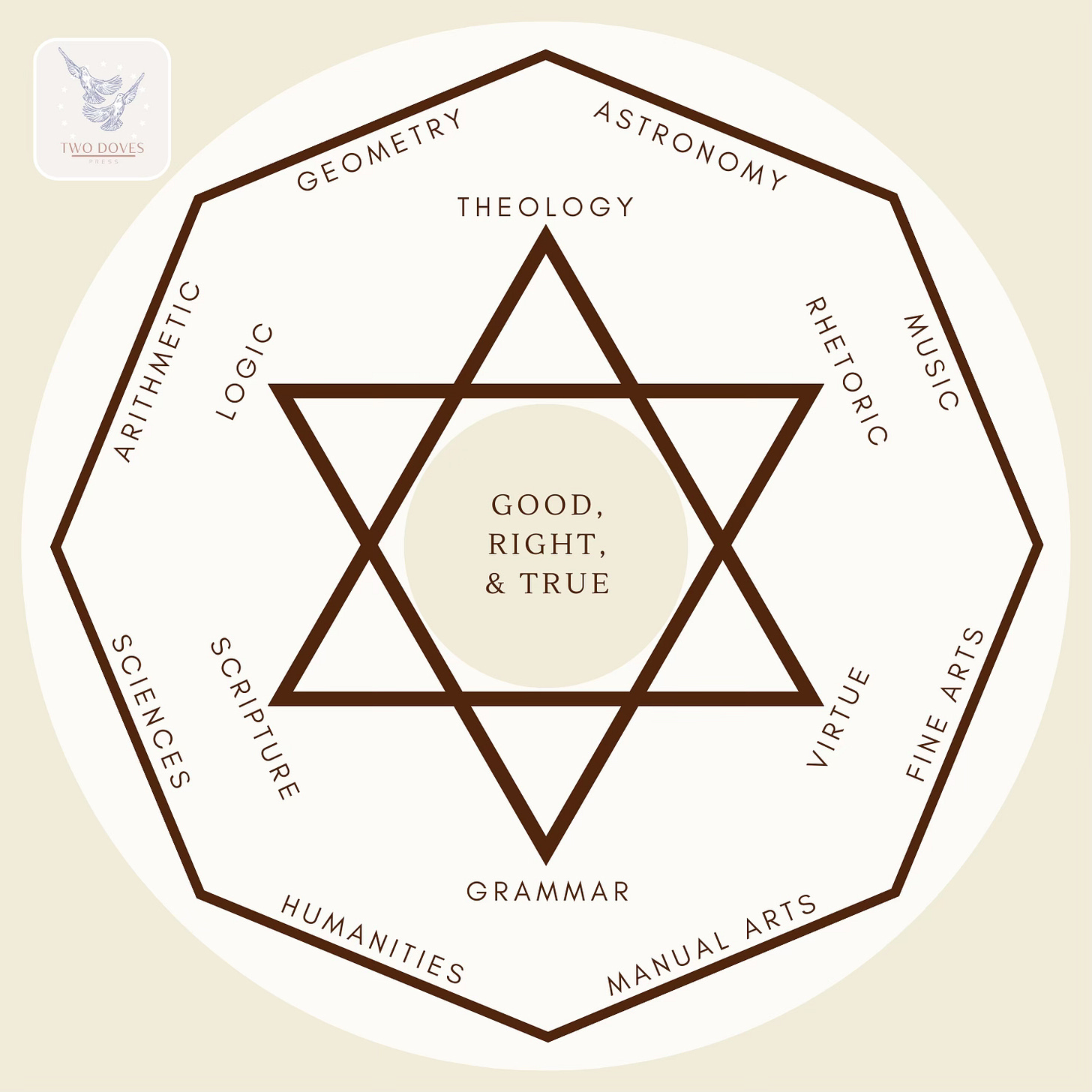This post originally appeared on March 6, 2024 as a blog post on TwoDovesPress.com.
As of 2025, I have additional thoughts on this subject which have evolved out of this first post and which I hope to share soon!
Contents:
- Classical Education is more than the Seven Liberal Arts
- Truth: The Guiding Principle
- The Trinity of Truth
- What about Truth, Beauty, and Goodness?
- All that is Good, Right, and True
- The Beauty of this Blog Post
- The 14 Principles
When searching for the defining principles of Christian classical education, I have often found articles and videos explaining the importance of a virtuous education or the meaning of handing down tradition through education. Nearly all sources mention the seven liberal arts, and many go on to reference Plato, Aristotle, or Quintilian. Yet, the principles--the specific aspects--that define what constitutes a Christian classical education seem entirely elusive.
It is not that these principles are not discussed. Quite the opposite, the discussion surrounding the principles is so great that many classicists may have forgotten to state the specific. To them, these principles may be obvious. Wanting a classicist to state the principles of a true classical education may be like expecting a farmer to call a cow a cow. But, there is a need to make that which is obvious to some defined for everyone else. That is what I will endeavor to do.
Classical Education is more than the Seven Liberal Arts
With so much emphasis on the seven liberal arts--Grammar, Logic, Rhetoric (the Trivium), and Arithmetic, Geometry, Music, Astronomy (the Quadrivium), you would think that a classical education consisted of just these seven categories. At one time long ago, it did. But look into any classical curriculum today and you will find subjects that fall outside of the realms of the Trivium and Quadrivium. Compare various classical curricula and you will see that each differ on the type of subjects offered to the extent that one may wonder how each can be called "classical". Yet, these subjects can have a place within the educational philosophy.
We can categorize these subjects outside the seven liberal arts as the Modern Arts which include modern sciences, humanities, manual arts, and fine arts. These principles of education are often legally required teaching in the 21st century (specifically science and humanities) and have also grown out of the philosophical, scientific, and artistic developments of recent centuries. Pairing the seven liberal arts with the four modern arts gives us eleven principles, so far, of a classical education.
Truth: The Guiding Principle
Every educational philosophy, even one which calls itself secular, is guided by something considered to be truth. For classical education, this truth would be philosophy as handed down by the greatest thinkers of human history (Socrates, Plato, Aristotle, and so on). For Christian classical education, this truth would be theology as divinely revealed by God through His son Jesus Christ and divinely inspired through the writings of the greatest theological thinkers (St. Thomas Aquinas as well as other doctors of the Church). For the public school of the 21st century, this truth may be the political philosophy of the education system or, worse, may be devoid of a guiding principle of truth and subject to the relative truth of the individual administrators and teachers of each subject within the school.
Truth, sometimes referred to as Wisdom, is the ultimate guiding light of a classical education, particularly a Christian classical education. Without truth, the educational path is subject to the winds of culture, politics, and propaganda. Truth is not just an idea toward which one directs the path of education. Truth must be imparted within the education itself. It may be surprising then to learn that there are classical education programs that do not include philosophy or theology within the curriculum. As C.S. Lewis observes in The Abolition of Man:
The old dealt with its pupils as grown birds deal with young birds when they teach them to fly; the new deals with them more as the poultry-keeper deals with young birds— making them thus or thus for purposes of which the birds know nothing. In a word, the old was a kind of propagation—men transmitting manhood to men; the new is merely propaganda.
The propagation of truth is at the heart of an education and further, the formation of a person. It is absolutely necessary for a classical education to be defined in philosophical or theological truth to be considered classical at all.
The Trinity of Truth
Truth in classical education has three principles. (Yes, we are adding three to those eleven from earlier.) The principles of truth are Morals, Ethics, and Philosophy. But, this definition of Truth differs in Christian classical education.
Truth in Christian classical education has grown out of these classical truths to establish a new trinity of Truth, a Christ-centered Truth. The principles of truth are Scripture, Virtues, and Theology. This replaces (or, arguably, fulfills) the traditional classical object of truth with a new trinity of truth pointing to the Truth of Christ.
Even so, the difference between philosophy and theology may not be immediately apparent. The difference becomes clear when we consider the object--the Truth-- of each. One is man's search for meaning in himself and in the world; the other is divine revelation of man's meaning in God. For Christians, Christ is the Way, the Truth, and the Life (John 14:6). God has revealed ultimate Truth through His Son. Therefore, a Christian classical education must not stop at philosophy but integrate theology and lead a student toward the revelation of Jesus, the wisdom of St. Paul, and the writings of great theologians so that the student's entire education and formation grow toward the Truth of God.
What about Truth, Beauty, and Goodness?
Often when reading within the classical sphere, the phrase "truth, beauty, and goodness" appears. We've just discussed philosophy and theology (and their related principles) within the topic of Truth. Are truth, beauty, and goodness therefore all part of a classical education? Is this just a motto? (I won't go too far into the weeds of philosophy here, so stick with me!)
This phrase originates with the transcendental properties of philosophy: Being, Something, Unity, Truth, and Goodness. Notice that Beauty is not listed here. In the book Elementary Course of Christian Philosophy, the beautiful is defined as "that which pleases when known," (The Brothers of Christian Schools, p.156). The Brothers of Christian Schools go on to explain:
All beauty is founded on truth, the natural object of the intellect; hence beauty is not arbitrary, but, like truth, immutable; for it has its eternal type in God. (p.157)
Beauty then is not a principle discipline of classical education but a judgment we make when perceiving something as being in accord with Truth. It is not Beauty that instructs Beauty but Truth that instructs. One who is not ordered toward Truth will ignore or overlook the beauty that points to God. One who is ordered toward God cannot miss the beautiful that points, always, toward Him.
Goodness, however, is on the list. The Brothers of Christian Schools present the following definition, "Goodness is the conformity of a thing to the will, especially to the divine will," (p.151) and go on to specify, "The good is also divided into useful, honorable, and pleasurable," (p.153). It seems then that the Good is what we do, produce, create, study or even embody as in accord with Truth. The product of goodness would go on to elicit a judgment of beauty. This goodness may then be associated with the arts (both liberal and modern) of an education.
All that is Good, Right, and True
While the phrase "truth, beauty, and goodness" holds a place of prestige for good reason and remains theologically sound, I would like to offer the words of St. Paul, an apostle of Jesus Christ, which he wrote in a letter to the Ephesians as the guiding principles of Christian classical education: Goodness, Righteousness, and Truth. Or, the Good, Right, and True.
Why Right? While "righteous" is often synonymous with "holy", we may see this term also as rightly order toward God, pointed to the object of Truth. To be in communion with God, to be rightly ordered toward Him, it is necessary to have language to comprehend and communicate:
As men are composed of body and soul, they require an exterior sign to communicate their thoughts to one another; the most perfect sign is that of language...We must allow that speech is the principal means by which the greater part of knowledge is communicated in a prompt and easy manner, especially that knowledge which relates to spiritual things and to moral truths. (The Brothers of Christian Schools, p.114-115)
For this reason, what is Right has its foundation in language, communication, and comprehension--all the elements of the Trivium. It is rightly understanding, rightly thinking, and rightly speaking. The Right is the bridge between the Truth of God imparted to us and the Good of man in action. The Right makes the propagation of Truth possible. It makes the beauty of the Good comprehendible.
Together, the Good, Right, and True order the disciplines of a Christian classical education into one.
The Beauty of this Blog Post
I've made some images, or infographics, that I hope you will find informative—and beautiful—in visualizing all of this information.
Through these images, you see the Good comprised of the four arts of the Quadrivium and the four Modern Arts, the Right comprised of the Trivium, and the True comprised of the Christian trinity of Truth.
This gives us 14 principle disciplines to a Christian classical education:
Arithmetic
Geometry
Astronomy
Music
Science
Humanities
Manual Arts
Fine Arts
Grammar
Logic
Rhetoric
Scripture
Virtue
Theology
For the fruit of light is found in all that is good, right, and true.
Ephesians 5:9







This is brilliant and a very helpful read! The graphics at the end were exactly what I needed to order all of it together. I look forward to your expanded thoughts on this topic!